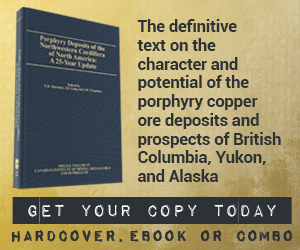Library Magazine Articles An update on harmonization of 2014 CIM Definition Standards
An update on harmonization of 2014 CIM Definition Standards
Paul Bankes - May 2015
Part one of two
The CIM Definition Standards for Mineral Resources and Mineral Reserves were updated in 2014 to harmonize Canadian definitions with other members of the Committee for Mineral Reserve International Reporting Standards (CRIRSCO). The revised Canadian standard also incorporates industry, Canadian Securities Administrators (CSA) and international requests for clarification and guidance. This update is important for Qualified Persons filing public reports on Mineral Resources and Mineral Reserves.
The CIM Standing Committee on Mineral Reserve and Mineral Resource Definitions, which I chair, maintains CIM definitions referenced by National Instrument 43-101 Standards of Disclosure for Mineral Projects (NI 43-101) and represents CIM on CRIRSCO.
Following extensive consultations with industry, CIM members and the CSA staff, revisions were incorporated in the final Definitions Standards that were approved by CIM Council on May 10, 2014.
CRIRSCO was formed in 1994 under the auspices of the Council of Mining and Metallurgical Institutes (CMMI) to represent CIM and its seven partner organizations responsible for developing mineral reporting codes: the Australasian Joint Ore Reserves Committee, the Chile-based National Committee, Europe’s Pan-European Reserves & Resources Reporting Committee, the Mongolian Professional Institute of Geosciences and Mining, Russia’s National Association for Subsoil Use Auditing, South Africa’s South African Code for Reporting of Exploration Results, Mineral Resources and Mineral Reserves (SAMREC) and the Society for Mining, Metallurgy and Exploration of the U.S. With increased international exposure, CRIRSCO members agreed in 2011 on 13 harmonized core definitions that had drifted from the definitions accepted in 1997 under the Denver Accord.
For international practitioners reporting under multiple CRIRSCO codes and standards, the core definitions in the 2014 CIM Definition Standards are now harmonized with CRIRSCO definitions as well as seven of eight member codes. In some cases, the core definitions are followed by additional national code or guidance. SAMREC is expected to incorporate CRIRSCO core definitions in 2015. The following examples identify significant harmonization changes that affect the Canadian definitions.
Mineral Resource
The 2005 and 2010 CIM definitions of a Mineral Resource differed from the definitions of other CRIRSCO members in two key aspects: the inclusion of “solid material” and the exclusion of “reasonable prospects for eventual economic extraction.”
The Canadian definition has always included the word “solid,” but other CRIRSCO members omitted it. In 2011, however, all members agreed to include the phrase “solid material” in their respective codes to address the recent reporting of lithium brines as Mineral Resources. CRIRSCO members concluded that the nature and the risk associated with lithium brine estimates would be better captured by probabilistic definitions, considering porosity and permeability than by the more deterministic CRIRSCO definitions.
In a similar fashion, the CIM definition has historically excluded the word “eventual,” from the phrase “reasonable prospects for eventual economic extraction,” which had been adopted by all other CRIRSCO members. The committee added the word “eventual” to the Canadian definition and provided the following guidance:
Interpretation of the word ‘eventual’ in this context may vary depending on the commodity or mineral involved. For example, for some coal, iron, potash deposits and other bulk minerals or commodities, it may be reasonable to envisage ‘eventual economic extraction’ as covering time periods in excess of 50 years. However, for many gold deposits, application of the concept would normally be restricted to perhaps 10 to 15 years, and frequently to much shorter periods of time.
While the committee acknowledges the word “eventual” relaxes the definition by extending project timing beyond the moment of reporting, we believe the new wording is reasonable and accurately reflects current industry practice. The new guidance was inserted to limit the timeframe that should be considered by the required Qualified Person when preparing mineral resource estimates.
Mineral Reserves
In 2012 the UN Expert Group on Resource Classification noted that the CRIRSCO template for reporting a Mineral Reserve did not identify a “reference point.” This is particularly important when Mineral Reserves are reported as a product, such as clean coal, rather than as feed to a plant or concentrator. The following text was included in the new CRIRSCO and CIM definition:
“The reference point at which Mineral Reserves are defined, usually the point where the ore is delivered to the processing plant, must be stated. It is important that, in all situations where the reference point is different, such as for a saleable product, a clarifying statement is included….”
The committee included the following guidance in the CIM Definition Standards to assist the practitioner:
‘Reference point’ refers to the mining or process point at which the Qualified Person prepares a Mineral Reserve. For example, most metal deposits disclose mineral reserves with a “mill feed” reference point. In these cases, reserves are reported as mined ore delivered to the plant and do not include reductions attributed to anticipated plant losses. In contrast, coal reserves have traditionally been reported as tonnes of “clean coal.” In this coal example, reserves are reported as a “saleable product” reference point and include reductions for plant yield (recovery). The Qualified Person must clearly state the ‘reference point’ used in the Mineral Reserve estimate.
My next article will focus on the alignment of the Standard with NI 43-101 for the permitted disclosure of economic analyses.
Author
Paul Bankes is a geologist with more than 30 years of domestic and international experience in project development, mine operations, geostatistics, mine design and business development. Paul chairs the CIM Standing Committee on Mineral Reserve and Mineral Resource Definitions and represents CIM on CRIRSCO and the UN Experts Committee on Resource Classification.

.png)
